Quantitative Evaluation Method and Process of BIM Data for Generating BIM-Based 2D Deliverables
Abstract
:1. Introduction
1.1. Background and Purpose of Research
1.2. Research Scope and Method
2. Relevant Research
2.1. Evaluation of BIM Maturity
2.2. Evaluation of BIM Outcomes
2.3. Summary
3. Derivation of Evaluation Items for BIM Data Assessment
3.1. Analysis of the Work Process to Create 2D Deliverables in BIM
3.2. Analysis of BIM Drawing Data
- Components derived from the geometry of BIM model data:
- 2.
- Components based on the parameter information of BIM model data:
- 3.
- Additional components not inherent in BIM model data:
3.3. Derivation of Evaluation Indexes
3.3.1. BIM Data Readiness Index
3.3.2. BIM Data Consistency Index
4. Quantitative Evaluation Method for BIM Data and 2D Deliverables
4.1. Establishment of BIM Data Evaluation Criteria
4.1.1. Establishment Process of BDRI Evaluation Criteria
4.1.2. Establishment Process of BDCI Evaluation Criteria
4.2. BDRI Composition and Evaluation Process
4.2.1. Element BDRI Evaluation Method
4.2.2. Attribute BDRI Evaluation Method
4.3. BDCI Composition and Evaluation Process
BDCI Evaluation Method
5. Pilot Test and Verification
5.1. Overview of Pilot Test
5.2. Analysis of Work Productivity Based on BOMI-2D
5.2.1. Overview of Productivity Analysis
5.2.2. Analysis of User Tasks According to BOMI-2D
5.2.3. Comparative Analysis of Evaluation Results
6. Conclusions
Author Contributions
Funding
Data Availability Statement
Conflicts of Interest
References
- Shin, J.H.; Choi, J.S.; Kim, I.H. Development of IT BSC-Based Assessment System to Measure BIM Performance for Architectural Design Firms. J. Archit. Inst. Korea Plan. Des. 2016, 32, 3–12. [Google Scholar] [CrossRef]
- Song, J.K.; Ju, K.B. Development of Rule for Quality Checking Items to Raise Quality of BIM Model-Focusing on the Domestic BIM Guidelines-. Korean J. Constr. Eng. Manag. 2013, 14, 131–143. [Google Scholar] [CrossRef]
- Donato, V.; Lo Turco, M.; Bocconcino, M.M. BIM-QA/QC in the Architectural Design Process. Archit. Eng. Des. Manag. 2018, 14, 239–254. [Google Scholar] [CrossRef]
- Zadeh, P.A.; Wang, G.; Cavka, H.B.; Staub-French, S.; Pottinger, R. Information Quality Assessment for Facility Management. Adv. Eng. Inform. 2017, 33, 181–205. [Google Scholar] [CrossRef]
- Leygonie, R.; Motamedi, A.; Iordanova, I. Development of Quality Improvement Procedures and Tools for Facility Management BIM. Dev. Built Environ. 2022, 11, 100075. [Google Scholar] [CrossRef]
- Becerik-Gerber, B.; Rice, S. The Perceived Value of Building Information Modeling in the US Building Industry. J. Inf. Technol. Constr. 2010, 15, 185–201. [Google Scholar]
- Kim, Y.; Chin, S.; Choo, S. BIM Data Requirements for 2D Deliverables in Construction Documentation. Autom. Constr. 2022, 140, 104340. [Google Scholar] [CrossRef]
- Level of Development Specification. 2022. Available online: https://bimforum.org/wp-content/uploads/2022/06/BIMForum_LOD-Spec-2020.zip (accessed on 29 June 2023).
- BS EN ISO 19650-1:2018 Organization and Digitization of Information about Buildings and Civil Engineering Works, Including Building Information Modelling (BIM). Information Management Using Building Information Modelling—Concepts and Principles. Available online: https://knowledge.bsigroup.com/products/organization-and-digitization-of-information-about-buildings-and-civil-engineering-works-including-building-information-modelling-bim-information-management-using-building-information-modelling-concepts-and-principles/standard (accessed on 29 June 2023).
- Version 4.2 bSI Candidate Standard IFC Bridge Extension. Now Part IFC. p 4.3.x Release Cycle. Available online: https://standards.buildingsmart.org/IFC/DEV/IFC4_2/FINAL/HTML/ (accessed on 29 June 2023).
- Chen, Z.S.; Zhou, M.D.; Chin, K.S.; Darko, A.; Wang, X.J.; Pedrycz, W. Optimized Decision Support for BIM Maturity Assessment. Autom. Constr. 2023, 149, 104808. [Google Scholar] [CrossRef]
- Wu, C.; Xu, B.; Mao, C.; Li, X. Overview of BIM Maturity Measurement Tools. J. Inf. Technol. Constr. Itcon 2017, 22, 34–62. Available online: https://www.itcon.org/papers/2017_03-ITcon-Wu.pdf (accessed on 29 June 2023).
- Yilmaz, G.; Akcamete, A.; Demirors, O. A Reference Model for BIM Capability Assessments. Autom. Constr. 2019, 101, 245–263. [Google Scholar] [CrossRef]
- Kwon, O.; Jo, C.W.; Cho, J.W. A Study on the Systematization of Open BIM Data Quality Management. J. Archit. Inst. Korea Struct. Constr. 2012, 28, 105–112. [Google Scholar] [CrossRef]
- Getting Help on Archicad. Volume 26. Available online: https://help.graphisoft.com/AC/26/INT/index.htm?#t=_AC26_Help%2F001_ACHelpIntro%2F001_ACHelpIntro-1.htm (accessed on 29 June 2023).
- Lu, W.; Chen, K.; Zetkulic, A.; Liang, C. Measuring Building Information Modeling Maturity: A Hong Kong Case Study. Int. J. Constr. Manag. 2021, 21, 299–311. [Google Scholar] [CrossRef]
- Edirisinghe, R.; Pablo, Z.; Anumba, C.; Tereno, S. An Actor–Network Approach to Developing a Life Cycle Bim Maturity Model (Lcbmm). Sustainability 2021, 13, 13273. [Google Scholar] [CrossRef]
- Kam, C.; Senaratna, D.; Xiao, Y.; McKinney, B. The VDC Scorecard: Evaluation of AEC Projects and Industry Trends; Center for Integrated Facility Engineering: Maharashtra, India, 2013. [Google Scholar]
- Du, J.; Liu, R.; Issa, R.R. BIM Cloud Score: Benchmarking BIM Performance. J. Constr. Eng. Manag. 2014, 140, 04014054. [Google Scholar] [CrossRef]
- Liang, C.; Lu, W.; Rowlinson, S.; Zhang, X. Development of a Multifunctional BIM Maturity Model. J. Constr. Eng. Manag. 2016, 142, 06016003. [Google Scholar] [CrossRef]
- NBIMS. ver.3. 2015 National BIM Standard (NBIMS)–United States, Annex A: COBie Mapping Rules. Volume 2015. Available online: https://www.nationalbimstandard.org/files/NBIMS-US_V3_4.2_COBie_Annex_A.pdf (accessed on 29 June 2023).
- Paulk, M.C.; Curtis, B.; Chrissis, M.B.; Weber, C.V. Capability Maturity Model, version 1.1. IEEE Softw. 1993, 10, 18–27. [Google Scholar] [CrossRef]
- ISO/IEC, 2015a. ISO/IEC 33001 Information Technology — Process Assessment — Concepts and Terminology. Available online: https://www.iso.org/obp/ui/#iso:std:iso-iec:33001:ed-1:v1:en (accessed on 9 November 2023).
- Kim, S.; Chin, S.; Han, J.; Choi, C.H. Measurement of construction BIM value based on a case study of a large-scale building project. J. Manag. Eng. 2017, 33, 05017005. [Google Scholar] [CrossRef]
- Kwon, O.; Jo, C.W. Proposal of BIM Quality Management Standard by Analyzing Domestic and International BIM Guides. J. Korea Inst. Build. Constr. 2011, 11, 265–275. [Google Scholar] [CrossRef]
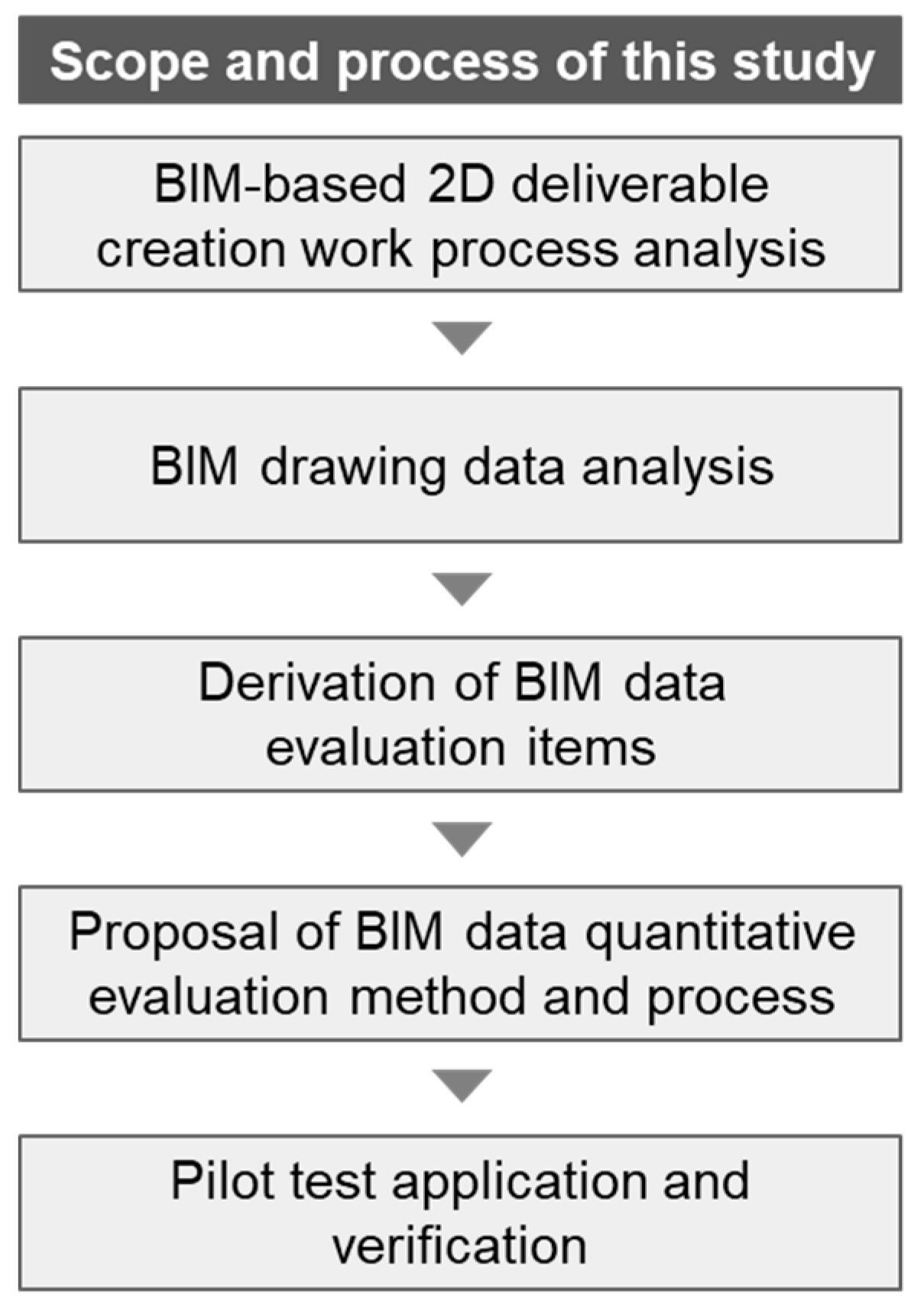

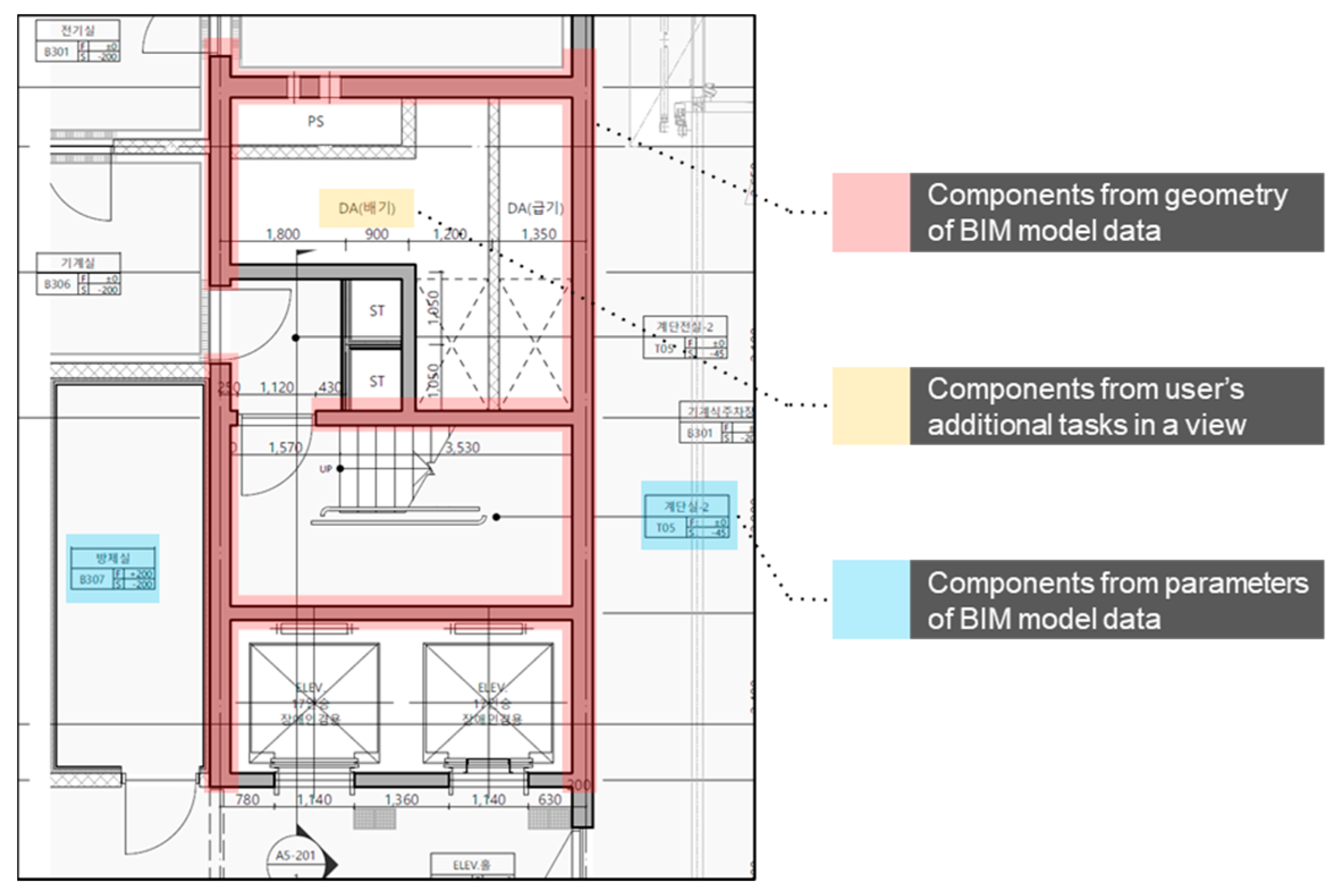
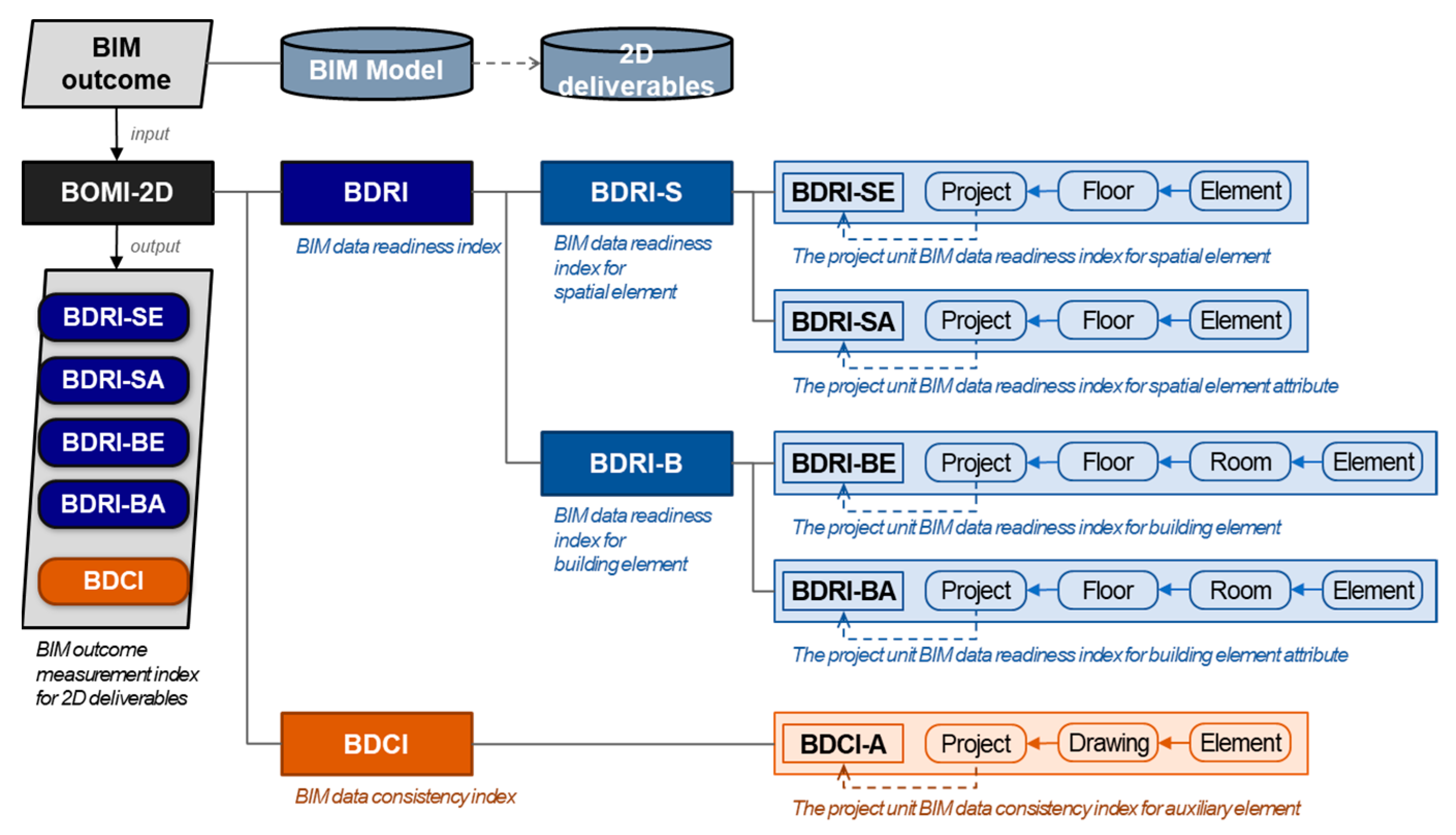
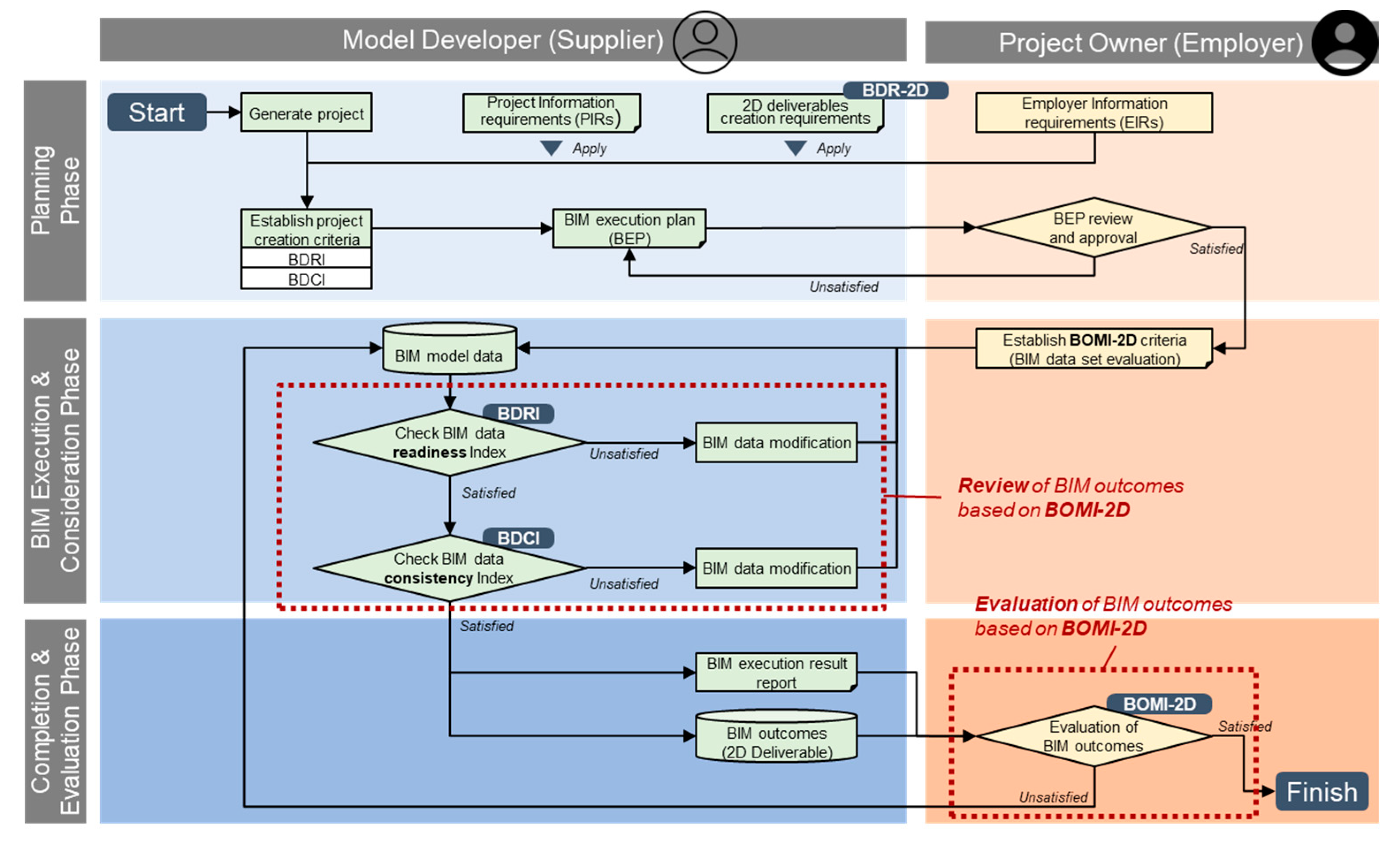


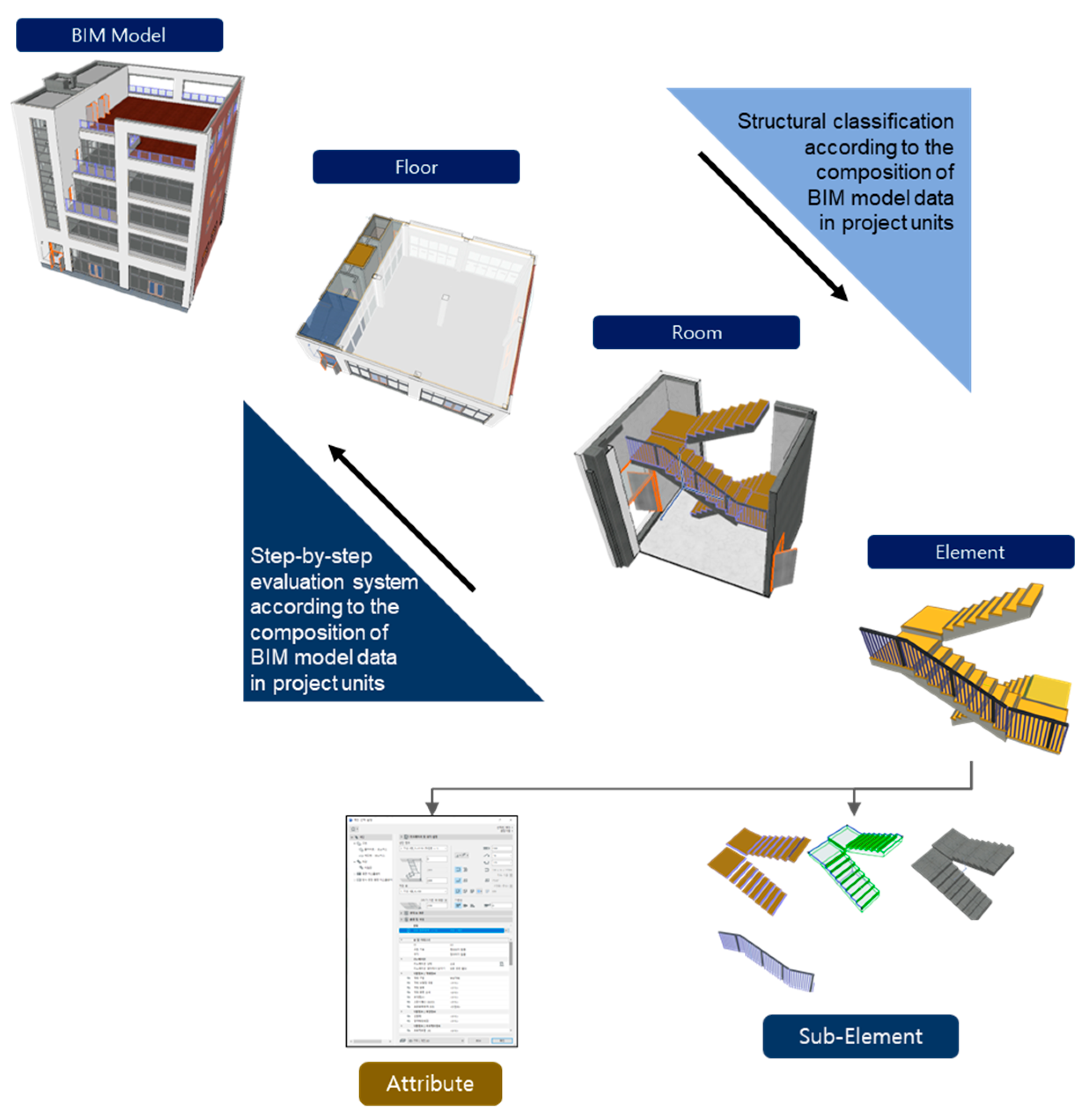
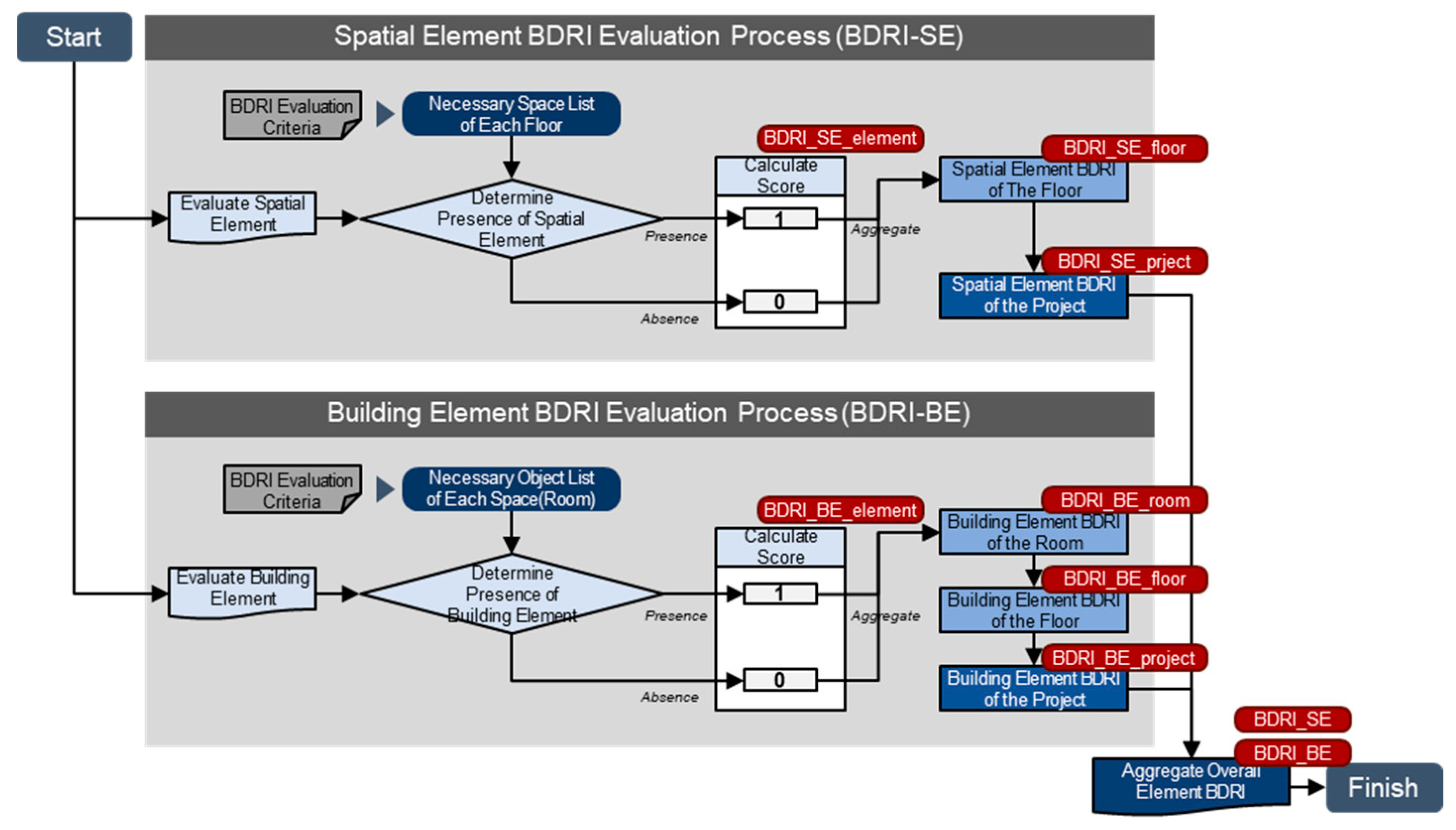
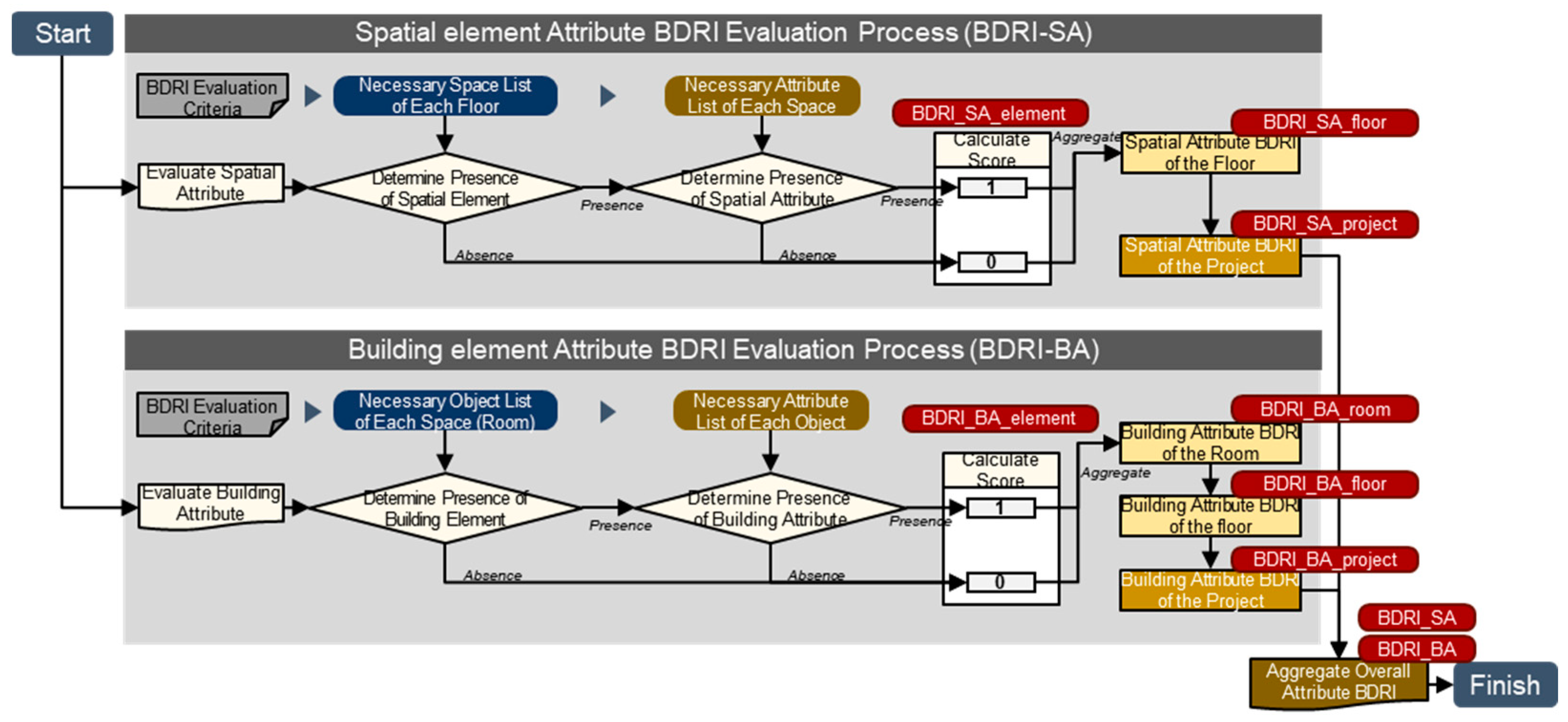
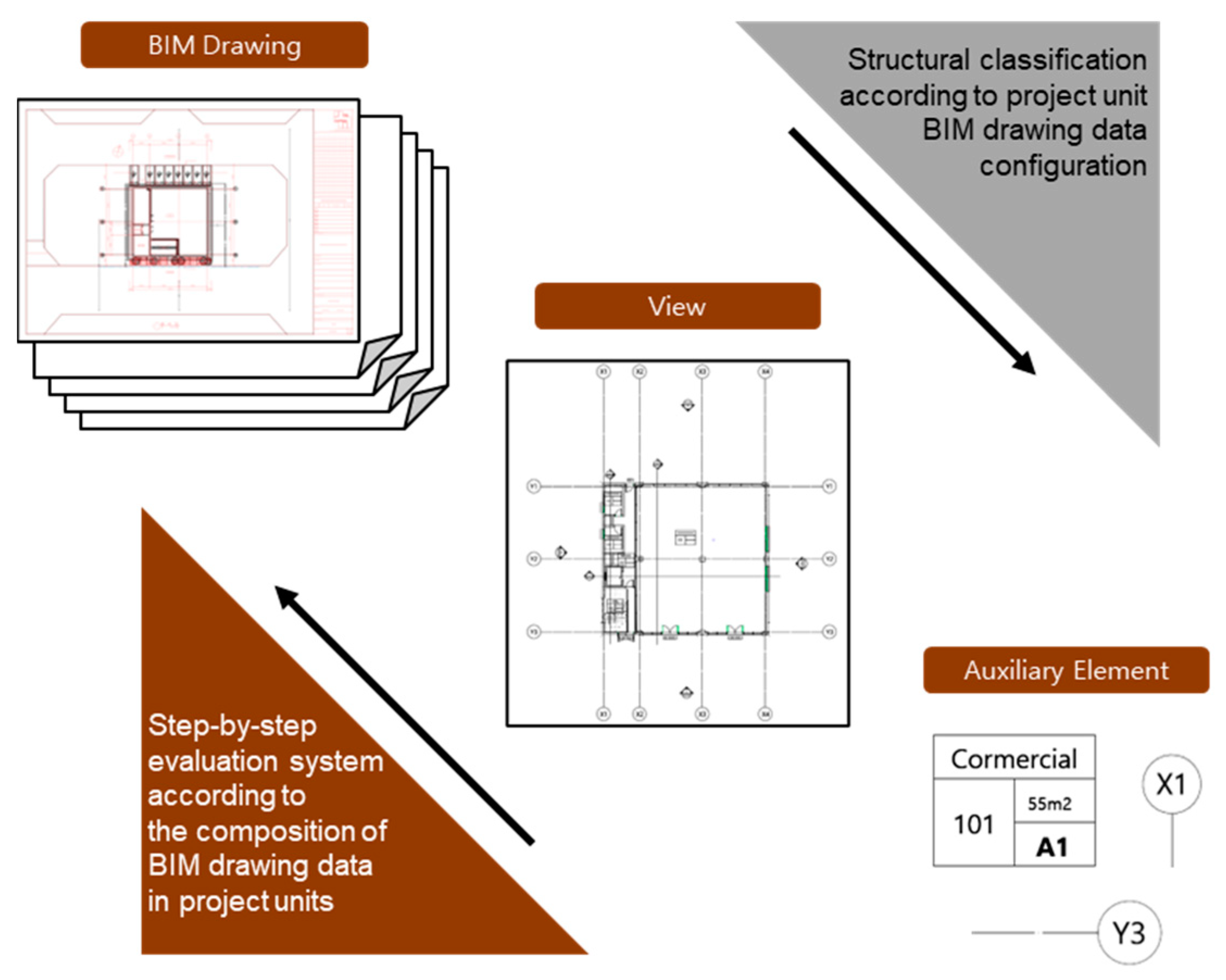



| Floor | Room Configuration (IfcLongName) | Necessary Room List |
|---|---|---|
| B1 | Mechanical service | ✓ |
| Elevator pit | ✓ | |
| Core pit | ✓ | |
| Electrical pipe shaft | ✓ | |
| Telecommunication pipe shaft | ✓ | |
| Stair hall | - | |
| Parking lot | ✓ | |
| … | … | … |
| Building Element List | Necessary Building Element per Space | |||||
|---|---|---|---|---|---|---|
| Object Type | IFC Object Type | IFC Predefined Type | IFC User Defined Type | Lobby | Stair Hall | ··· |
| Structural wall | IfcWall | By type | ✓ | ✓ | ··· | |
| Architectural wall | IfcWall | By type | - | ✓ | ··· | |
| Wall covering | IfcCovering | USERDEFINED | WALL_FINISHING | ✓ | ✓ | ··· |
| Slab | IfcSlab | By type | ✓ | ✓ | ··· | |
| Slab finishing | IfcCovering | USERDEFINED | SLAB_FINISHING | ✓ | ✓ | ··· |
| RC column | IfcCloumn | USERDEFINED | COLUMN_RC | ✓ | ✓ | ··· |
| Steel column (H) | IfcCloumn | USERDEFINED | COLUMN_HSTEEL | ✓ | - | ··· |
| RC beam | IfcBeam | USERDEFINED | BEAM_RC | ✓ | ✓ | ··· |
| Building Element List | Necessary Building Element per Space | |||||||
|---|---|---|---|---|---|---|---|---|
| Parent-Element | Sub-Element | Lobby | Stair Hall | ··· | ||||
| Object Type | IFC | Object Type | IFC Object Type | IFC Predefined Type | IFC User Defined Type | |||
| Stair | IfcStair | StairFlight | IfcStairFlight | By type | - | - | ✓ | ··· |
| Stair landing | IfcSlab | USERDEFINED | STAIR_LANDING | - | ✓ | ··· | ||
| Tread | IfcMember | USERDEFINED | STAIR_TREAD | - | ✓ | ··· | ||
| Treadnose | IfcCovering | USERDEFINED | STAIR_TREAD_TREADNOSE | - | ✓ | ··· | ||
| Nonslip | IfcCovering | USERDEFINED | STAIR_TREAD_NONSLIP | - | ✓ | ··· | ||
| Riser | IfcMember | USERDEFINED | STAIR_RISER | - | ✓ | ··· | ||
| Stair railing | IfcRailing | USERDEFINED | STAIR_RAILING | - | ✓ | ··· | ||
| Handrail | IfcRailing | USERDEFINED | STAIR_RAILING_HANDRAIL | - | ✓ | |||
| Balustrade | IfcRailing | USERDEFINED | STAIR_RAILING_BALUSTRADE | - | ✓ | |||
| Stair finishing | IfcCovering | USERDEFINED | STAIR_FINISHING | - | ✓ | ··· | ||
| Element Class | Attribute List | Necessary Attribute per Space | |||
|---|---|---|---|---|---|
| Level 1 | Level 2 | Elevator Hall | Stair Hall | … | |
| Spatial element | Identification | GUID | ✓ | ✓ | … |
| Member name (ID) | ✓ | ✓ | … | ||
| Project name (ID) | ✓ | ✓ | … | ||
| Location | Facility name | ✓ | - | … | |
| Zone name | ✓ | - | … | ||
| Floor name | ✓ | ✓ | … | ||
| Shape | Room height | ✓ | ✓ | … | |
| Room area | ✓ | ✓ | … | ||
| Finishing | Floor finishing | ✓ | ✓ | … | |
| Wall finishing | ✓ | ✓ | … | ||
| Ceiling finishing | - | ✓ | … | ||
| Element Class | Level of Building Parameter | Necessary Attribute per Space | |||
|---|---|---|---|---|---|
| Level 1 | Level 2 | Lobby | Stair Hall | … | |
| Stair | Identification | GUID | ✓ | ✓ | … |
| Member name (ID) | ✓ | ✓ | … | ||
| Project name (ID) | ✓ | ✓ | … | ||
| BIM data version | ✓ | ✓ | … | ||
| Location | Floor name | ✓ | ✓ | … | |
| Resource | Concrete strength | - | - | … | |
| Rebar strength | - | - | … | ||
| Evacuation stairs | ✓ | ✓ | … | ||
| Rebar detail | - | - | … | ||
| Shape | Stair width | ✓ | ✓ | … | |
| Step height | ✓ | ✓ | … | ||
| Step width | ✓ | ✓ | … | ||
| Number of steps | ✓ | ✓ | … | ||
| Auxiliary Element | IFC Information | Necessary Auxiliary Element List per Drawings | |||||
|---|---|---|---|---|---|---|---|
| IFC Object Type | IFC Predefined Type | IFC User Defined Type | Cross-Section | Core Enlarged Floor Plan | ··· | ||
| Reference element | Grid marker | IfcAnnotation | USERDEFINED | GRID_MARKER | ✓ | ✓ | ··· |
| Story marker | IfcAnnotation | USERDEFINED | STORYLEVEL_MARKER | ✓ | ✓ | ··· | |
| ··· | ··· | ··· | ··· | ··· | ··· | ··· | |
| Dimension element | Building planar dimension | IfcAnnotation | USERDEFINED | PLANAR_BUILDING_DIMENSION | - | ✓ | ··· |
| Planar dimension of space | IfcAnnotation | USERDEFINED | PLANAR_SPATIAL_DIMENSION | - | ✓ | ··· | |
| Planar dimension of element | IfcAnnotation | USERDEFINED | PLANAR_ELEMENT_DIMENSION | ✓ | - | ··· | |
| Floor step level | IfcAnnotation | USERDEFINED | SECTIONAL_LEVEL_FLOORSTEP | ✓ | - | ··· | |
| ··· | ··· | ··· | ··· | ··· | ··· | ··· | |
| Notation element | Legend | IfcAnnotation | USERDEFINED | LEGEND | ✓ | ✓ | ··· |
| Drawing information label | IfcAnnotation | USERDEFINED | DWGINFORMATION | ✓ | ✓ | ··· | |
| Opening symbol | IfcAnnotation | USERDEFINED | SYMBOLTYPE_OEPNING | ✓ | ✓ | ··· | |
| Space name label | IfcAnnotation | USERDEFINED | LABELTYPE_SPACEID | ✓ | ✓ | ··· | |
| ··· | ··· | ··· | ··· | ··· | ··· | ··· | |
| Drawing Type | Number of Drawings | Case A—Drawing Elements Not Linked with BIM Model | Case B—Drawing Elements Not Linked with BIM Model | ||||||||
|---|---|---|---|---|---|---|---|---|---|---|---|
| Element | Dimension | Annotation | Description | Sum | Element | Dimension | Annotation | Description | Sum | ||
| Architectural | 23 | 88 | 59 | 285 | 95 | 527 | 7 | 4 | 4 | 38 | 53 |
| Floor plan | 14 | 35 | 7 | 135 | 27 | 204 | 4 | 2 | 2 | 20 | 28 |
| Core enlarged floor plan | 2 | 4 | 0 | 21 | 5 | 30 | 0 | 0 | 0 | 5 | 5 |
| Core enlarged cross-section | 2 | 12 | 29 | 31 | 14 | 86 | 0 | 0 | 0 | 5 | 5 |
| Elevation | 2 | 4 | 0 | 38 | 2 | 44 | 0 | 0 | 0 | 2 | 2 |
| Cross-section | 2 | 24 | 19 | 48 | 38 | 129 | 0 | 0 | 0 | 4 | 4 |
| Layout | 1 | 9 | 4 | 12 | 9 | 34 | 3 | 2 | 2 | 2 | 9 |
| Structural | 16 | 10 | 29 | 20 | 32 | 91 | 0 | 0 | 0 | 19 | 19 |
| Structural plan | 14 | 10 | 29 | 16 | 28 | 83 | 0 | 0 | 0 | 17 | 17 |
| Structural cross-section | 2 | 0 | 0 | 4 | 4 | 8 | 0 | 0 | 0 | 2 | 2 |
| Total | 39 | 98 | 88 | 305 | 127 | 618 | 7 | 4 | 4 | 57 | 72 |
| Comparative Analysis Result | Original BIM Data (Case A) | Modified BIM Data (Case B) | Difference Ratio (%) | |
|---|---|---|---|---|
| BOMI-2D output | BDRI-SE | 0.90 | 1.00 | ▲ 10.0% |
| BDRI-BE | 0.68 | 1.00 | ▲ 32.0% | |
| BDRI-SA | 0.72 | 1.00 | ▲ 28.0% | |
| BDRI-BA | 0.70 | 1.00 | ▲ 30.0% | |
| BDCI | 0.68 | 1.00 | ▲ 32.0% | |
| Additional tasks | Building element | 98 | 7 | ▼ 92.9% |
| Dimension | 88 | 4 | ▼ 95.5% | |
| Annotation | 305 | 4 | ▼ 98.7% | |
| Description | 127 | 57 | ▼ 55.1% | |
| Total | 618 | 72 | ▼ 88.3% | |
Disclaimer/Publisher’s Note: The statements, opinions and data contained in all publications are solely those of the individual author(s) and contributor(s) and not of MDPI and/or the editor(s). MDPI and/or the editor(s) disclaim responsibility for any injury to people or property resulting from any ideas, methods, instructions or products referred to in the content. |
© 2023 by the authors. Licensee MDPI, Basel, Switzerland. This article is an open access article distributed under the terms and conditions of the Creative Commons Attribution (CC BY) license (https://creativecommons.org/licenses/by/4.0/).
Share and Cite
Kim, Y.; Chin, S.; Choo, S. Quantitative Evaluation Method and Process of BIM Data for Generating BIM-Based 2D Deliverables. Buildings 2023, 13, 3124. https://doi.org/10.3390/buildings13123124
Kim Y, Chin S, Choo S. Quantitative Evaluation Method and Process of BIM Data for Generating BIM-Based 2D Deliverables. Buildings. 2023; 13(12):3124. https://doi.org/10.3390/buildings13123124
Chicago/Turabian StyleKim, Yije, Sangyoon Chin, and Seungyeon Choo. 2023. "Quantitative Evaluation Method and Process of BIM Data for Generating BIM-Based 2D Deliverables" Buildings 13, no. 12: 3124. https://doi.org/10.3390/buildings13123124
APA StyleKim, Y., Chin, S., & Choo, S. (2023). Quantitative Evaluation Method and Process of BIM Data for Generating BIM-Based 2D Deliverables. Buildings, 13(12), 3124. https://doi.org/10.3390/buildings13123124







